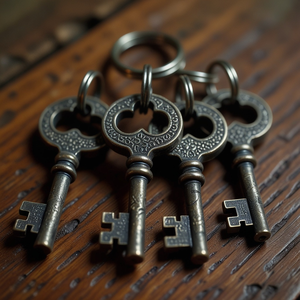Guide: Securing Your Bitcoin Keys - An Overview

By Colonial
Cryptocurrency has been marketed as a revolution in finance, but it actually has nothing to do with finance. What it really does is allow you to truly control your funds - no third parties or intermediaries, no asking permission to spend your money, no terms of service, no censorship, and if done right, no tracing. The banks and payment processors that most use everyday work as trusted intermediaries, but they also monitor, censor and, in extreme cases, confiscate money. Bitcoin flips that model on its head: there is no central authority—only you and the network. The trade‑off is that you alone are responsible for safeguarding your bitcoin. This post lays out the fundamentals of how that works, why it matters, and how to keep your keys safe.
Keys, seeds and the paradox of trust
Bitcoin works because of cryptographic keys. A private key is just a very large number that proves you own a corresponding bitcoin address. Possession of that number is what authorises spending. Anyone who knows your private key can move your coins. For most people, memorising or even storing dozens of 256‑bit keys is impractical. That’s where seed phrases come in.
A seed phrase (sometimes called a recovery phrase or mnemonic) is a short list of words generated by your wallet that encodes all the information needed to restore your private keys. In other words, your seed phrase is your wallet: if your computer dies or your phone is lost, you can reinstall the wallet software and type in the seed phrase to regain access. The seed is generated from a carefully chosen word list; each word represents a number, and the sequence can be converted to the seed integer used to derive all future key pairs. In simpler terms, you can mathematically derive all your keys from your seed phrase. Because seed phrases use natural language words, they’re easier to read and less prone to transcription errors than raw private keys.
Seed phrases typically follow the BIP‑39 standard, which uses word lists of 2048 words to generate phrases of 12 or more words. A 12‑word seed phrase has 128 bits of security—comparable to the security of a Bitcoin private key. Wallet software will randomly select 12 or more words from that list to create your wallet. It’s tempting to think you could just pick the words yourself, but humans are bad at generating randomness. The best practice is to let the wallet generate the seed and then write it down.
The safety of a seed phrase is deceptive. It’s usually just a string of English words written on paper, but anybody who finds it can steal your money. Because it holds the keys to your entire wallet, you should treat it like cash or jewelry and store it accordingly. Many people engrave their seed on metal plates, store copies in safe‑deposit boxes or distribute fragments among trusted contacts. Paper backups degrade over time; metal can withstand fires and floods. The medium doesn’t matter as long as it’s secure, durable and private. In a separate post, I'll give step-by-step directions for properly securing your seed.
Passphrases: adding a second factor
Storing potentially life‑changing sums on a single piece of paper makes some people uneasy. To reduce the risk, many wallets support the addition of a passphrase—an extra word or sentence that modifies the seed. BIP‑39 defines an optional passphrase that produces a completely different wallet from the same seed. Electrum and some other wallets call this a “seed extension” or “13th/25th word”. Think of it as two‑factor authentication for your seed: you need both the seed phrase and the passphrase to recover the wallet. If a thief finds your seed phrase but doesn’t know the passphrase, they can’t unlock your funds.
Passphrases are powerful, but they come with considerations. First, you have to remember it. Forgetting the passphrase renders your wallet and any money it contains permanently inaccessible. Second, if you die or are incapacitated, your heirs need to know both the seed and the passphrase. Some people address this by writing the passphrase down and storing it separately from the seed. The key point is that a passphrase increases security by adding something you know to something you have, but it also increases complexity.
Hot wallets vs. cold storage
First, understand that a bitcoin or crypto wallet is just a place to store your private keys in a software suite that allows you to use those keys to sign transactions. All transactions must be signed in order for the network to consider them valid. So, wallets hold your keys and they sign transactions. Some wallets will also connect to the network to verify how much bitcoin you control with those keys. These are called "hot" wallets.
When people talk about “hot” and “cold” wallets, they’re really discussing network exposure. A hot wallet is connected to the internet. It could be a mobile app, a desktop program or a browser extension. Hot wallets are convenient: you can transact quickly, receive payments, and spend on the fly. The trade‑off is that the device holding your keys is potentially exposed to malware and hacking. Because the private key or seed is stored on an internet‑connected machine, an adversary could theoretically extract it if your operating system is compromised.
By contrast, a cold wallet (often called cold storage) keeps your keys offline. Cold wallets come in several forms: hardware wallets, paper wallets, air‑gapped computers or even steel plates buried in your backyard. Since they’re never connected to the internet, they dramatically reduce the attack surface. However, they’re less convenient for frequent transactions—you need to sign a transaction on the offline device and then transfer it to an online computer for broadcasting. Most serious holders keep a small amount in a hot wallet for daily spending and the bulk of their holdings in cold storage. In separate posts, I'll give step-by-step guides for using recommended hot/cold wallets for both mobile and desktop.
Best practices for storage and recovery
The following are a solid overview of how to store your bitcoin keys. If you're not sure how to implement any one of these points, don't worry, I'll be creating guides for exactly how to do this. For now, it's important that you understand the principles.
- Generate your seed offline. Use a reputable wallet or hardware device to generate your seed. Don’t rely on online seed generators or random word lists. Follow the device’s instructions and verify that the seed is random.
- Write it down and test it. Physically record the seed phrase and, if you’re using one, the passphrase. Immediately perform a test recovery on a separate device to ensure you wrote it down correctly. Mistakes happen; catching them early prevents heartbreak later.
- Store backups securely. Keep multiple backups in separate, secure locations. A house fire or flood can destroy a single piece of paper. Consider metal plates or fireproof safes. Avoid leaving your seed in plain sight or storing it digitally unencrypted.
- Beware of phishing and malware. Never enter your seed phrase or passphrase into a website or app other than your wallet’s recovery screen. Scammers often create fake wallet interfaces to trick users into revealing their recovery phrases. Verify wallet software before entering your seed.
- Plan for inheritance. Your bitcoin won’t magically pass to your heirs when you die. Consider how your loved ones will access your funds. This might involve a written document explaining what a seed phrase is and how to use it, or using multisignature schemes where multiple keys are needed to spend.
- Update and verify firmware. Hardware wallets occasionally release firmware updates to fix bugs and security vulnerabilities. Verify firmware from official sources and check signatures where possible. Tampered firmware could compromise your keys.
Final thoughts
Self‑custody of bitcoin is empowering because it removes middlemen, but it also imposes responsibilities. Understanding the basics—keys, seed phrases, passphrases and storage methods—is non‑negotiable. A hot wallet offers convenience for everyday spending. For larger holdings, a hardware wallet keeps your keys offline and under your control. By taking the time to learn and implement proper security practices, you can enjoy the benefits of bitcoin while mitigating the risks. There’s no bank to bail you out if you make a mistake, and that's a good thing—so treat your seed phrase like the keys to your vault and own your fortune with sovereignty.


